Nyheter
Capturing opportunities in a transforming Saudi Arabia
Publicerad
5 år sedanden

You can now gain pure exposure to the Saudi Arabian equity market via our new Invesco MSCI Saudi Arabia UCITS ETF. This passive ETF is the first in Europe to offer targeted exposure to the largest economy in the Middle East. Capturing opportunities in a transforming Saudi Arabia.
Why Saudi Arabia?
- Economy is undergoing major transformation
“Vision 2030” programme of social and economic reforms is intended to diversify the Saudi economy away from such a heavy reliance on oil and government funding. Domestically, this includes increasing use of solar and other renewable energy sources, and increasing the number of Saudis in private employment.
Internationally, they are trying to leverage the country’s unique geographical position between three continents, and encouraging major domestic corporations to expand across borders and into global markets. They also want to attract foreign investors and visitors.
Saudi Vision 2030 goals
| Saudi Vision 2030 goals* | 2016 | 2030 |
|---|---|---|
| Reducing unemployment | 11.6% | 7% |
| Increasing non-oil exports (% of GDP) | 36% | 50% |
| Increasing contribution of FDI (% of GDP) | 3.8% | 5.7% |
| Increasing private sector contribution (% of GDP) | 40% | 65% |
| Increasing annual visitors to Umrah | 8 million | 30 million |
*Source: vision2030.gov.sa
- IPO pipeline, including Aramco
The kingdom is planning to sell 5% of state-owned Saudi Aramco, partly to help fund the reform programmes. This could raise upwards of $100 billion, and is likely to be the largest IPO in history. This along with several other significant IPOs in the pipeline will expand the diversification of the index composition, open investment opportunities and increase the importance of the Saudi equity market for international investors.
- Inclusion to MSCI Emerging Markets index should drive inflows
Since 2015, the government has introduced reforms to make it easier for foreign investors to gain meaningful access to the Saudi equity market. These have included easing requirements for foreign investors and bringing trade settlement more in line with global standards.
As a result, MSCI is considering reclassifying Saudi Arabia to Emerging Market status (from Standalone Market) when it announces the result of its annual review on 20 June 2018. If successful, as widely expected, Saudi Arabia will be included in the MSCI Emerging Market index from June 2019.
MSCI suggests the weighting of Saudi Arabia will be around 2.3% of the MSCI Emerging Markets index, placing it behind just South Africa and Russia among countries in the EMEA region. However, this proportion would rise significantly following the planned IPOs of Aramco and others.
- What happens next?
Although past performance is in no way an indicator for the future, it is still worth looking at what happened when other Middle East countries went through similar exercises. Both the MSCI United Arab Emirates (UAE) and MSCI Qatar indices saw strong performances following the announcement by MSCI that they were going to be included in the Emerging Markets index.
The country indices benefited from investors beginning to increase exposure leading up to their inclusion in the MSCI Emerging Markets index a year later.

Source: Bloomberg. Past performance is not a reliable indicator of future returns.

Source: Bloomberg. Past performance is not a reliable indicator of future returns
Invesco MSCI Saudi Arabia UCITS ETF
This is the first Saudi Arabia ETF listed in Europe. It provides passive exposure to an MSCI index that has been capped to meet UCITS criteria and avoid over-concentration.
About the index
The MSCI Saudi Arabia 20/35 index comprises 32** large- and mid-cap stocks, covering approximately 85% of the free float-adjusted market capitalisation in Saudi Arabia. To ensure the index meets UCITS diversification requirements and avoids overconcentration:
- The weight of the largest stock is constrained at 35%, and all other companies at 20%
- An investability screen is applied to determine the universe of eligible index constituents
- The index is reviewed and rebalanced quarterly.
**Source: MSCI, as at 14 June 2018
Investment risk factors
As this is an emerging markets ETF, investors should be prepared to accept a higher degree of risk than for an ETF investing in the securities of issuers in other more established economies or developed countries, as difficulties in dealing, settlement and custody could arise.
The Fund is exposed to the risk of bankruptcy, or any other type of default of the counterparty related to any trading transaction entered into by the Fund.
In order to reach its investment objective, the Fund enters into swap agreements which provide the performance of the Reference Index, and may imply a range of risks which could lead to an adjustment or even the early termination of the swap agreement.
On-exchange liquidity may be limited due insufficient demand, Reference Index suspension, a decision by one of the relevant stock exchanges, or a breach by the market maker of respective stock exchange requirements and guidelines. This may result in share prices that differ significantly from the NAV.
Important information
Investors should note that the price of your investment may go down as well as up. As a result you may not get back the amount of capital you invest.
This communication contains information that is for discussion purposes only, and is intended only for professional investors pursuant to Directive 2004/39/EC (MIFID) Annex II Section I in Austria, Finland, Germany, Italy, Luxembourg, the Netherlands, Norway, Spain, Sweden and the UK, Qualified Clients in Israel, and Qualified Investors in Switzerland. The products may only be offered and the Key Investor Information Document (KIID) and prospectus (the “offering documents”) and marketing materials may only be distributed in other jurisdictions in compliance with private placement rules and local regulations. This communication is not for distribution to, or for the attention of, US or Canadian persons.
Without limitation, this communication does not constitute an offer or a recommendation to enter into any transaction. When making an investment decision, you should rely solely on the final documentation and any prospectus relating to the transaction and not this summary.
Investment strategies involve numerous risks. Any calculations and charts set out herein are indicative only, make certain assumptions and no guarantee is given that future performance or results will reflect the information herein. Investors should consult their own business, tax, legal and accounting advisors with respect to this proposed transaction and they should refrain from entering into a transaction unless they have fully understood the associated risks and have independently determined that the transaction is appropriate for them. In no way should we be deemed to be holding out as financial advisers or fiduciaries of the recipient hereof.
UCITS ETF’s units / shares purchased on the secondary market cannot usually be sold directly back to UCITS ETF. Investors must buy and sell units / shares on a secondary market with the assistance of an intermediary (e.g. a stockbroker) and may incur fees for doing so. In addition, investors may pay more than the current net asset value when buying units / shares and may receive less than the current net asset value when selling them.
The funds or securities referred to herein are not sponsored, endorsed, or promoted by MSCI, and MSCI bears no liability with respect to any such funds or securities or any index on which such funds or securities are based. The prospectus contains a more detailed description of the limited relationship MSCI has with Invesco and any related funds.
The offering documents and financial reports for the products are available at etf.invesco.com.
In Israel, the contents of this document are restricted to Qualified Clients (pursuant to the First Schedule to the Israeli Regulation of Investment Advice, Investment Marketing and Investment Portfolio Management Law, 1995) only and are not intended for retail or private investors who are not Qualified Clients.
German investors may obtain the offering documents free of charge in paper or electronic form from the issuer or from the German information and paying agent (Marcard, Stein & Co AG, Ballindamm 36, 20095 Hamburg, Germany).
The representative and paying agent for the sub-funds of Invesco Markets plc, Invesco Markets II plc, and PIMCO Fixed Income Source ETFs plc in Switzerland is BNP Paribas Securities Services, Paris, succursale de Zurich, Selnaustrasse 16, 8002 Zurich, Switzerland. The offering documents, articles of incorporation and annual and semi-annual reports may be obtained free of charge from the representative in Switzerland. The ETFs are domiciled in Ireland.
The publication of the supplement in Italy does not imply any judgment by CONSOB on an investment in a product. The list of products listed in Italy, and the offering documents for and the supplement of each ETF are available: (i) at etf.invesco.com (along with the audited annual report and the unaudited half-year reports); and (ii) on the website of the Italian Stock Exchange borsaitaliana.it.
All investment decisions must be based only on information contained in the prospectus, the KIID/KID, the supplement and in the most recent audited annual report or unaudited semi-annual report. Investors should read the specific risks of any product they plan to invest in, which are noted in the prospectus, the KIID and the supplement. Past performance does not guarantee similar future performance. For details on fees and other charges, please consult the prospectus, the KIID and the supplement of each product.
This communication has been communicated by Invesco UK Services Limited, Perpetual Park, Perpetual Park Drive, Henley-on-Thames, Oxfordshire, RG9 1HH, authorised and regulated by the Financial Conduct Authority; Invesco Asset Management Deutschland GmbH, An der Welle 5, 60322 Frankfurt am Main, Germany; Invesco Asset Management SA, 16-18 rue de Londres, 75009 Paris, France; and Invesco Asset Management Limited, Perpetual Park, Perpetual Park Drive, Henley-on-Thames, Oxfordshire, RG9 1HH, United Kingdom. Authorised and regulated by the Financial Conduct Authority.
Du kanske gillar
-


ETF från Amundi på Xetra ger brett diversifierad exponering mot företag från utvecklade och tillväxtmarknader
-


EL40 ETF en återinvesterande fond som satsar på emerging markets
-


4UBL ETF investerar i emergings market, men inte i Kina
-


IS3C ETF dollardenominerade statsobligationer från emerging markets säkrade i Euro
-


5MVL ETF ger exponering mot värdeaktier i emerging markets
-


Indiens vikt i emerging market index stiger
Nyheter
Tillgång till italienska statsobligationer med fast löptid
Publicerad
13 timmar sedanden
24 april, 2024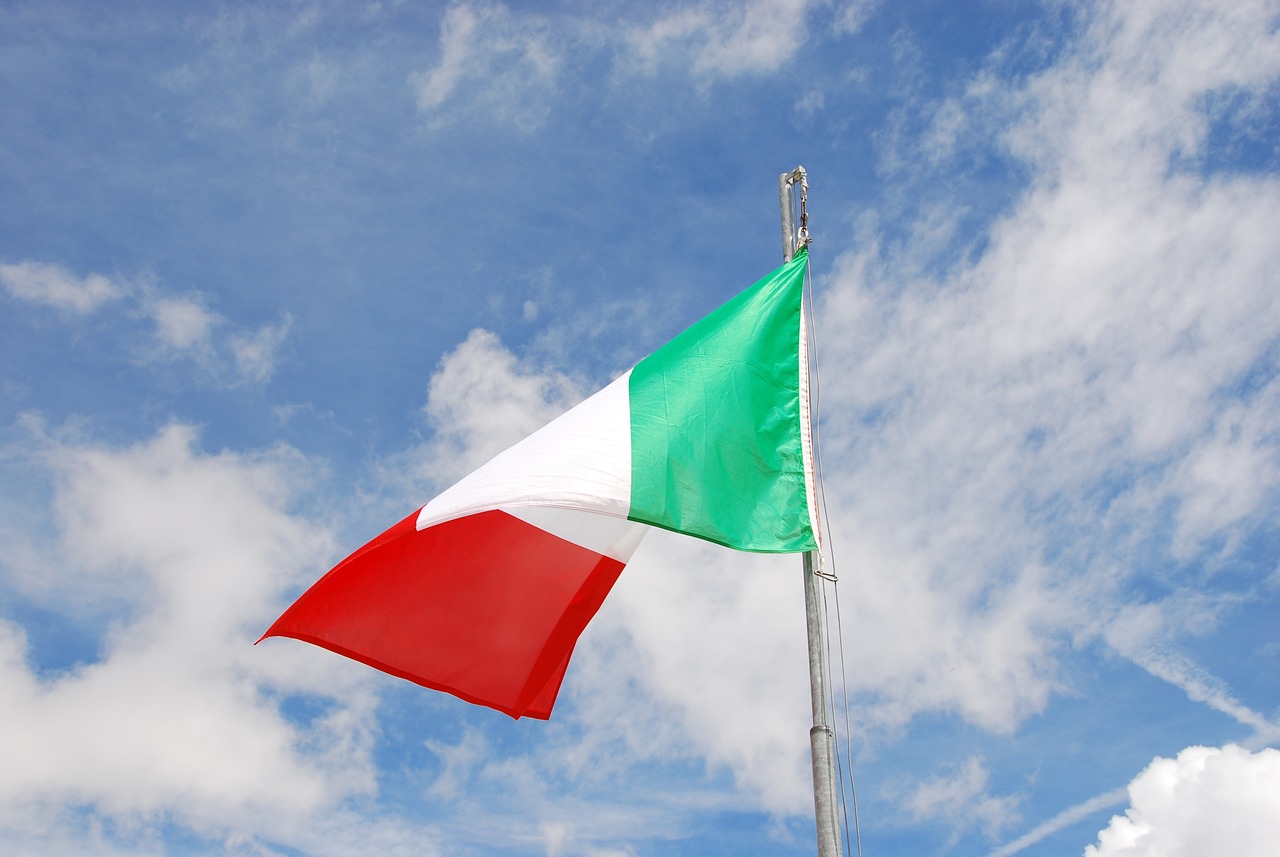
Sedan i onsdags har två nya börshandlade fonder utgivna av iShares kunnat handlas på Xetra och Börse Frankfurt. Dessa börshandlade fonder ger tillgång till italienska statsobligationer med fast löptid.
De två iShares iBonds dec 2026 och iShares iBonds dec 2028 Term € Italy Govt Bond UCITS ETFer ger investerare tillgång till en portfölj av eurodenominerade italienska statsobligationer som förfaller under samma kalenderår som ETFernas förfallodatum. Förfallodagen är satt till slutet av 2026 eller 2028. Vid löptidens slut likvideras den börshandlade fonden och portföljvärdet betalas ut till andelsägarna.
| Namn | ISIN | Avgift % | Utdelnings-policy | Referens- index |
| iShares iBonds Dec 2026 Term € Italy Govt Bond UCITS ETF (EUR) Dist) (26TP) | IE000LZ7BZW8 | 0,12 % | Utdelning | ICE 2026 Maturity Italy UCITS Index |
| iShares iBonds Dec 2028 Term € Italy Govt Bond UCITS ETF (EUR) Dist) (28IY) | IE000Q2EQ5K8 | 0,12 % | Utdelning | ICE 2028 Maturity Italy UCITS Index |
Produktutbudet i Deutsche Börses XTF-segment omfattar för närvarande totalt 2 156 ETFer. Med detta urval och en genomsnittlig månatlig handelsvolym på cirka 14 miljarder euro är Xetra den ledande handelsplatsen för ETFer i Europa.
Nyheter
Navigating Macro Headwinds, On-Chain Optics, and The Rise of Runes
Publicerad
14 timmar sedanden
24 april, 2024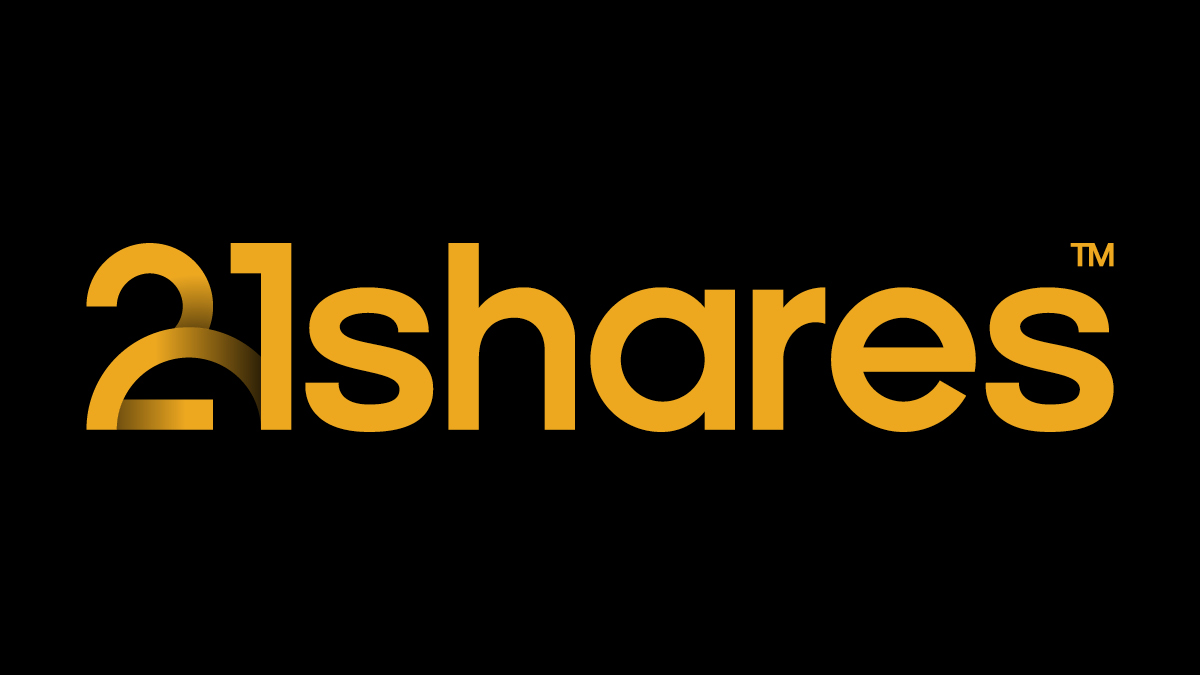
• Bitcoin Weathers Macroeconomic Storm
• Heightened User Activity, Soaring Transaction Fees, While Miners Sell Less
• Runes Protocol and Bitcoin’s Ever-Growing Ecosystem
Navigating Macro Headwinds, On-Chain Optics, and The Rise of Runes
This newsletter will be a Bitcoin-centric edition as we dissect the impact of recent macroeconomic events on Bitcoin’s price, followed up with an on-chain analysis of the network’s behavior post-halving. Additionally, we’ll explore some of the exciting innovations emerging within the Bitcoin ecosystem that were timed following the latest halving.
Bitcoin Weathers Macroeconomic Storm
The past two weeks have presented a challenging market environment for the crypto industry. As mentioned in our last newsletter, rising inflation in the U.S. remains, as evidenced by the higher-than-expected CPI print on April 9. Additionally, escalating conflict in the Middle East poses a significant threat to regional stability and added stress on the U.S. The potential of wider involvement from additional militant groups such as Lebanon’s Hezbollah, coupled with Iran’s control of a crucial maritime passage for commodity trading, the Strait of Hormuz, raise concerns about potential energy price hikes, steepening inflationary pressures and their effect on various asset classes.
Bitcoin initially reacted negatively to these events, experiencing an 8.22% drop in the immediate aftermath. Despite the 24/7 nature of crypto markets, which could have amplified the initial price shocks, Bitcoin’s underlying resilience shines through upon closer inspection. The S&P 500 fell by 2.03% on the market reopening last Monday and continues to tumble, while Bitcoin has recovered over 3.28% since the drawdowns, evidenced in Figure 1. This suggests a potentially more robust response to geopolitical turmoil compared to traditional assets, which is unsurprising given Bitcoin’s narrative as a flight to safety.
Figure 1: Bitcoin vs. Gold Price Performance Amid Geopolitical Tension
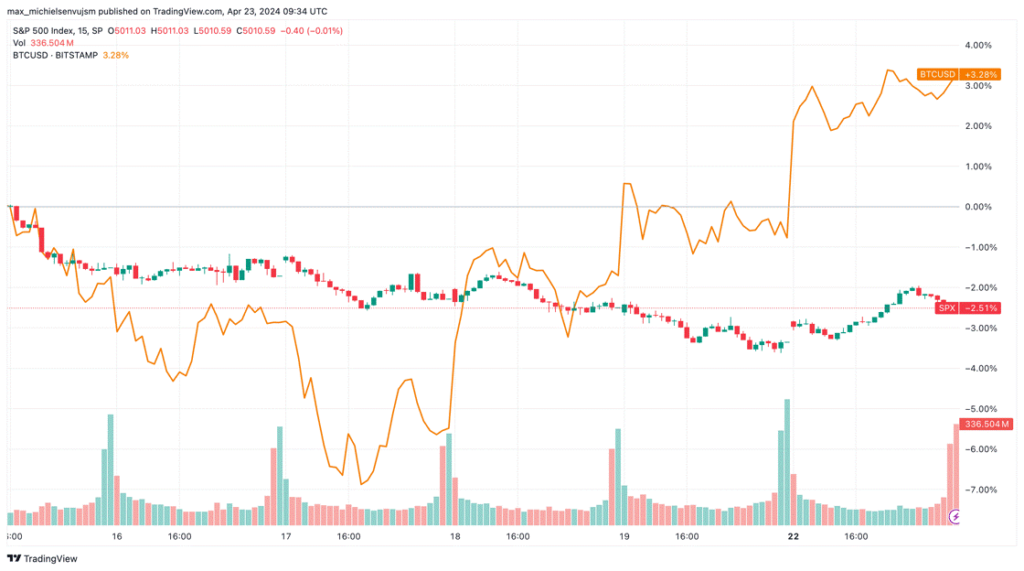
Source: TradingView
Examining Bitcoin’s market data, we see clear evidence that the futures market played a significant role in the initial price drops, which were attributed to the macroeconomic events of the last few weeks. A significant spike in long liquidations on the day of the attack, at $168M, suggests that some leveraged traders exited their positions, as shown below in Figure 2. Additionally, the high open interest at $35B leading up to the CPI print was followed by a recent $5B cool-off, indicating a correction in the futures market, reflected in the consolidation of the Bitcoin price.
Figure 2: Bitcoin Futures Long Liquidations, Short-Term and Long-Term Holder Supply
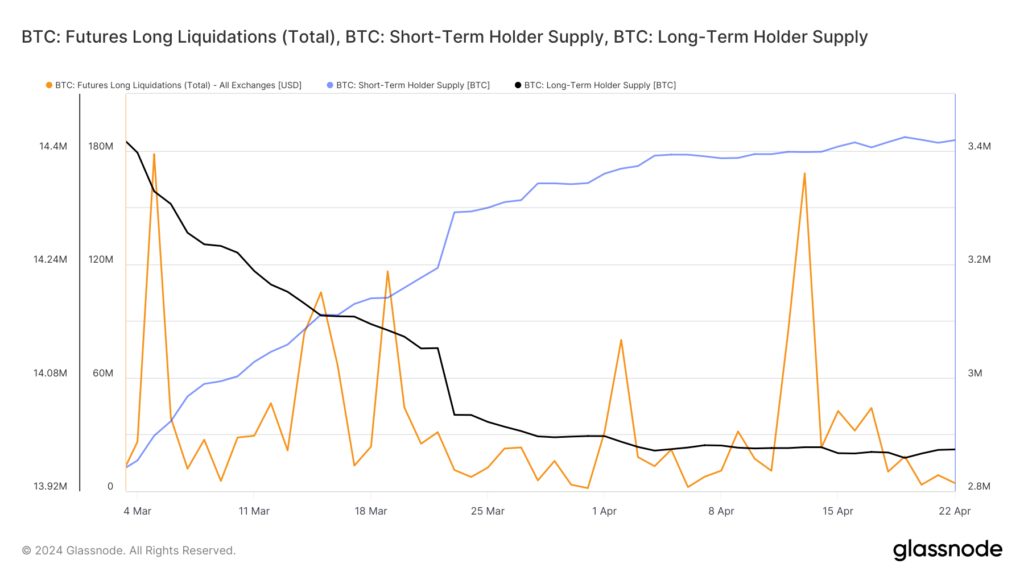
Source: Glassnode
Importantly, the spot market paints a more optimistic picture. In the last 10 days, which includes last week’s turbulence, long-term holders displayed minimal selling activity. Their holdings decreased by only 0.05%, while short-term holders continued to accumulate BTC, increasing their holdings by 0.5%. Notably, “Accumulation Addresses,” characterized by having no outbound transactions, holding more than 10 BTC, and not being affiliated with centralized exchanges or miners, have capitalized on the recent market dip. They currently hold over 3.17M BTC, accumulating over $2.3B since the CPI print, as evidenced below by Figure 3.
Figure 3 – Total Balance in Accumulation Addresses
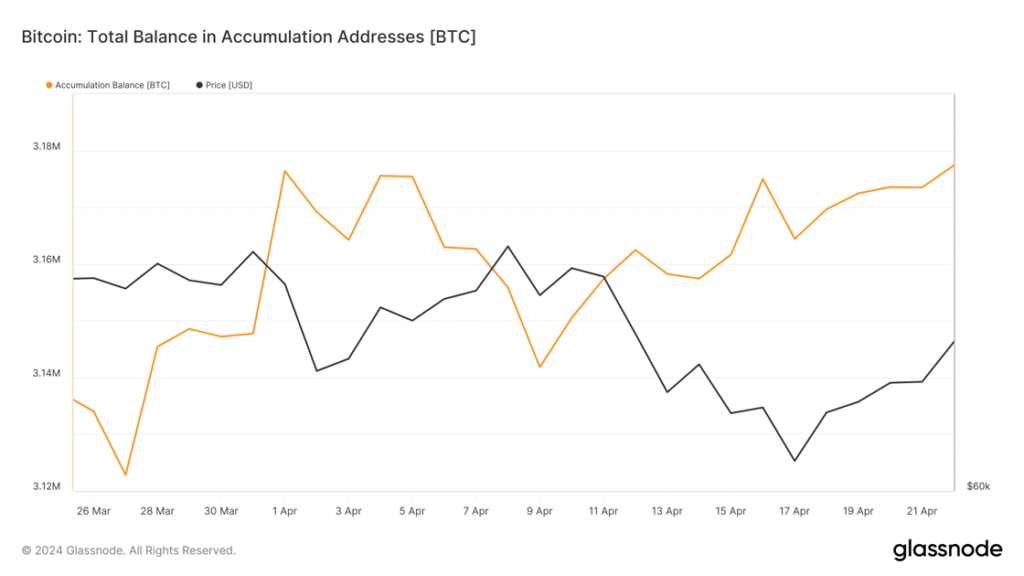
Source: Glassnode
Further bolstering the positive outlook, the 90-day due diligence period for U.S. spot Bitcoin ETFs has now concluded. According to Bloomberg, over 100 fund managers have disclosed their ownership of these products, signifying the growing institutional appetite for Bitcoin exposure, adding another layer of support to the asset class.
Heightened Activity, Soaring Transaction Fees, While Miners Sell Less
In the world of Bitcoin, transactions get logged onto a whiteboard-like structure, divided into cells called “blockspace,” where each cell represents a limited amount of space. Transaction fees play a crucial role in managing limited block space on the Bitcoin network. Users who pay higher fees get their transactions prioritized for confirmation within these blocks. This ensures smoother operation by preventing congestion and disincentivizing low-value spam transactions. Additionally, transaction fees serve as an important security measure. They incentivize miners to dedicate significant computing power to validate transactions and secure the network. Without these fees, mining might become less profitable, potentially jeopardizing network security.
Finally, transaction fees are at the core of Bitcoin’s economic sustainability as the mining reward gets halved every 210,000 blocks, transaction fees step up to fill the gap and pump miners’ revenue. We can already see the early innings of transaction fees rising against the issuance or block rewards since the launch of Ordinals in 2023, as shown in the chart below.
Figure 4 – Bitcoin Miners Revenue Breakdown
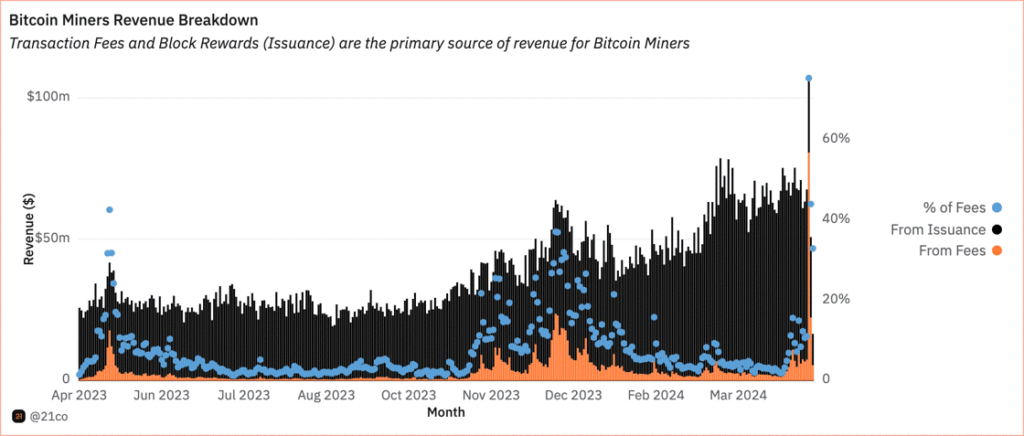
Source: 21co on Dune
It is no surprise that Bitcoin network activity has been high this year, with the amount of active addresses hovering between 700K and 1 million since January, up until the halving event. On-chain data reveals a lower-than-expected drop in active addresses following the halving, with transaction fees reaching new highs. While active addresses did experience a significant drop (43%) on April 19, falling from over 893K to 500K, they have already recovered 70K since then. Historically, the halving typically leads to a smaller decrease in active addresses (3-9%). This larger drop could indicate that rising fees are pricing some users out of the market for now, but as we’ll cover later, there are certain solutions being worked on to help alleviate this issue.
That said, transaction fees soared up to $128 on April 20, breaking $78M, tripling the previous all-time high, and making up 75% of Bitcoin miner revenue, as shown in Figure 4. The spike was primarily due to Ordinal-like inscriptions which have recently seen a spike thanks to Runes protocol, which we’ll delve deeper into in the last section. In line with this, the burgeoning Bitcoin ecosystem, expedited by Rune, has not only pushed Bitcoin out of its comfort zone unlocking new use cases, but also its transaction fees to surpass Ethereum’s since May 2023, as seen in Figure 5.
Figure 5 – BTC vs ETH fees (2 Years)
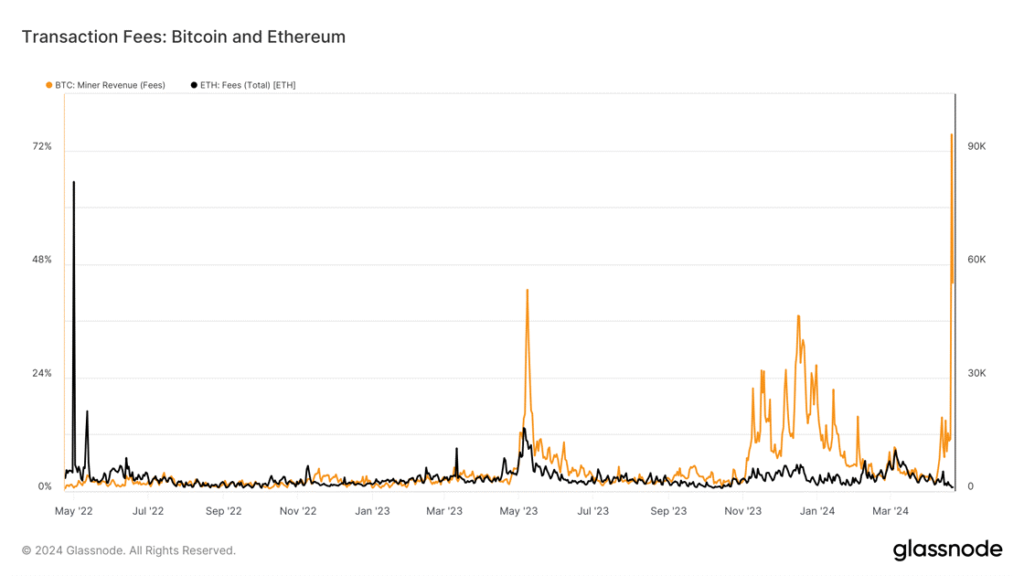
Source: Glassnode
The growth in transaction fees is appreciated even further, especially when we examine miner behavior following the halving event. Miners are now less motivated to immediately liquidate their freshly acquired BTC, as they can capitalize on an additional revenue stream apart from block rewards.
Let’s zoom in on miner activity after the halving. About 50 BTC were sold on centralized exchanges on April 20, which doesn’t compare to the sell-off of March 5 when approximately 1,154 BTC were sent to exchanges, pulling the asset to ~$64K, down from ~$68K, as shown in the chart below. The recent sale also doesn’t compare to the 307 BTC sold on the day following the previous halving in May 2020, when the asset was trading just below $9K.
Figure 6 – Transfer Volume from Bitcoin Miners to Exchanges in BTC (YTD)
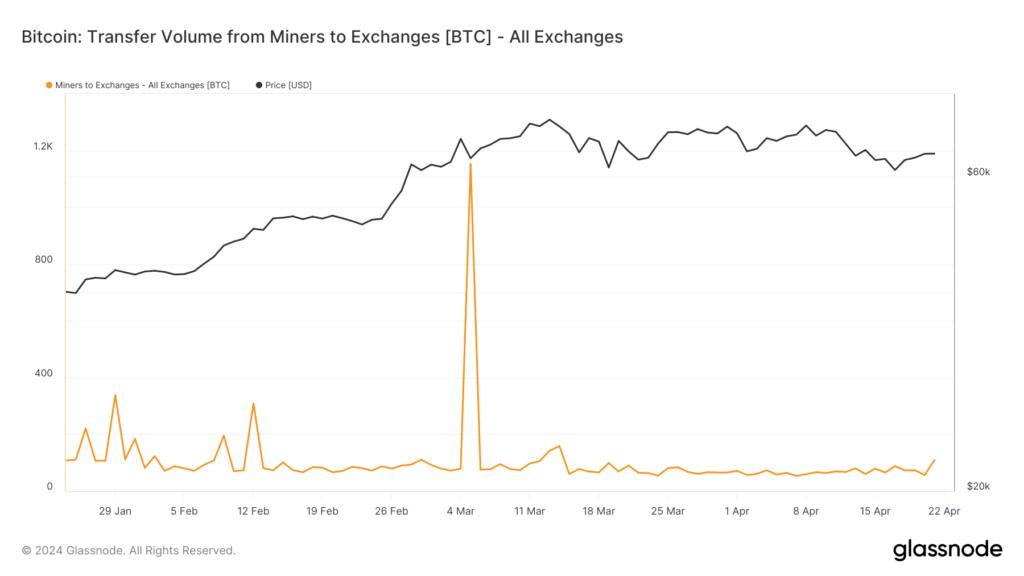
Source: Glassnode
The rising importance of Ordinal inscription, akin to non fungible tokens (NFTs), can be seen with Bitcoin generating $475M in real NFT sales versus Ethereum, which helps miners rake in more revenue and become sustainable. That said, the growing adoption of the Runes protocol is expected to drive even more activity toward the miners over the coming months.
Runes Protocol and Bitcoin’s Evergrowing Ecosystem
To recap, Runes streamlines the creation and management of fungible tokens on top of Bitcoin. It addresses the inefficiencies of the BRC20 standard, which have burdened the Bitcoin blockchain due to its inefficient data handling approach. That said, Runes achieves this in two key ways. Firstly, it optimizes transaction fees by consolidating multiple Unspent Transaction Output (UTXO) transactions into one bundle, leveraging Bitcoin’s accounting UTXO model. Additionally, it utilizes Bitcoin’s script, OP_Return, to inscribe data directly onto the blockchain, which serves to assign and transfer Runes balances within the network’s UTXOs. By minimizing data usage to 80 bytes, compared to BRC20’s 4MB, Runes prevents unnecessary bloat on the Bitcoin blockchain.
Ultimately, Runes presents an innovation aimed at bolstering Bitcoin’s security budget, offering miners an alternative revenue source to reduce their dependence on Bitcoin’s subsidized rewards over the long term. In fact, miners have earned about 1,500 BTC, valued at close to $100M in less than three days of trading activity, as seen below in Figure 7. To that end, Runes has garnered widespread support from the outset, with multiple Tier 2 exchanges such as OKX and Gate.io already announcing the listing of early collections like UNCOMMON.GOODS and MEME.ECONOMICS, which were among the first collections minted. Additionally, Binance appears to be hinting at support for meme tokens like Wizard and Pups, which were also among the first tokens to migrate from the BRC20 to the Runes standard. Meanwhile, NFT platforms like Magic Eden and Bitcoin-focused wallet provider Unisat are also joining the trend to capitalize on Runes’ growing popularity.
Figure 7: Fees Paid by Users to Mint Tokens Using the New Runes Protocol
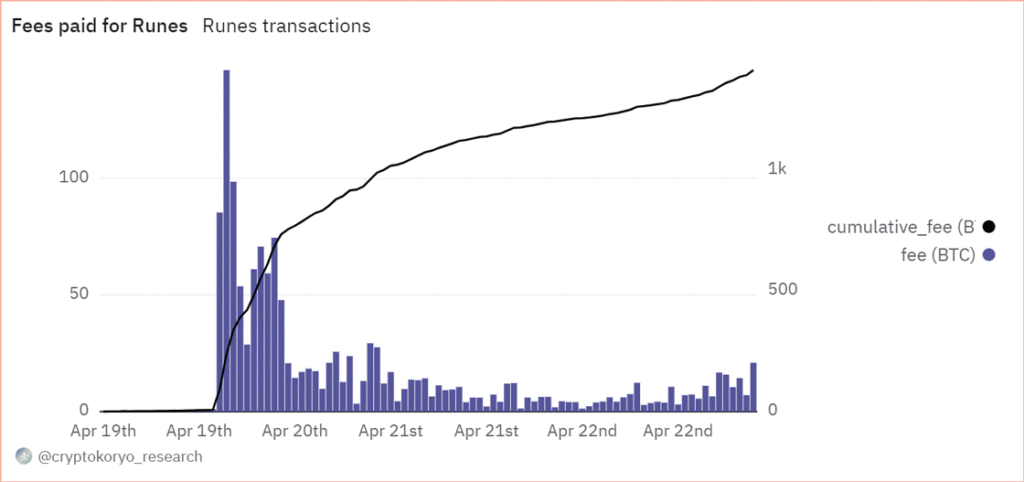
Source: CryptoKoryo on Dune
Following the pattern of past hype cycles, we anticipate that the initial excitement surrounding Runes will gradually subside, followed by a surge of heightened activity in the long run. This trend is often observed because the initial wave of interest tends to be on meme tokens, which can be quickly deployed and attract the masses’ attention, but often don’t add substantial value. However, as time progresses, sophisticated primitives like exchanges, automated market makers, and other DeFi lego blocks will begin emerging. These advancements will bolster Bitcoin’s capabilities at the application layer, streamlining the process of token trading on the Bitcoin network, much like ERC20/ERC721 did for Ethereum. In fact, when considering Bitcoin’s untapped market potential to establish its own fungible market ecosystem compared to other smart contract platforms, it becomes evident that there is substantial room for growth for this new generation of tokens, as illustrated in Figure 8 below.
Figure 8: The Market Opportunity for Bitcoin’s Fungible Tokens Ecosystem
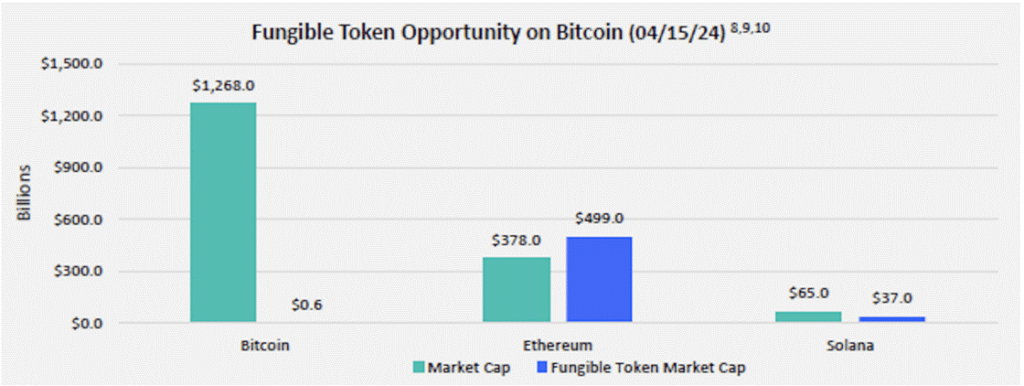
Source: FranklinTempleton
That said, Ordinals and Runes aren’t the only source of excitement pushing the boundaries of Bitcoin. For one, Bitcoin’s scaling solution Stacks began the first phase of its Nakamoto upgrade, called the instantiation stage, on April 22, while its final phase is expected to culminate by the end of May. As part of the upgrade, Stacks will introduce faster block processing times, enabling transactions to be finalized in under 5 seconds, a significant improvement from Bitcoin’s average of 10-30 minutes. Additionally, Stacks will leverage Bitcoin’s robust security guarantees, making transaction reversals on the Stacks network as challenging as those on the Bitcoin network. Furthermore, the upgrade will introduce a 1:1 BTC-backed asset (sBTC), enhancing the utility of Bitcoin by enabling its use across a diverse ecosystem of financial and gaming applications built on top of the scaling solution. The growing excitement surrounding its upgrade has pushed the total valued locked on the network to its highest point last week, reaching $170M.
On the other hand, there is a growing ecosystem of scaling solutions emerging on the back of BitVM, released last year. Standing for Bitcoin Virtual machine, this primitive is an operating system that allows for native smart-contract functionality on top of Bitcoin. It does so by introducing what’s known as a two-party provider verifier model that allows for complex computation to be executed off-chain, which can then be challenged on top of Bitcoin using fraud proofs, akin to how Arbitrum and Optimism function. To put it simply, BitVM enables Bitcoin to host more complex applications, which is giving birth to an embryonic L2 landscape, including Chainway, BitLayer, and Bob, amongst others, aiming to alleviate the issue of rising transaction costs. However, we will be closely monitoring this emerging sector, as there are numerous projects attempting to exploit the unprecedented enthusiasm for Bitcoin to launch potentially fraudulent protocols.
Bookmarks
Have you read our latest report, The Bitcoin Halving and Beyond? Click here to get a digital copy.
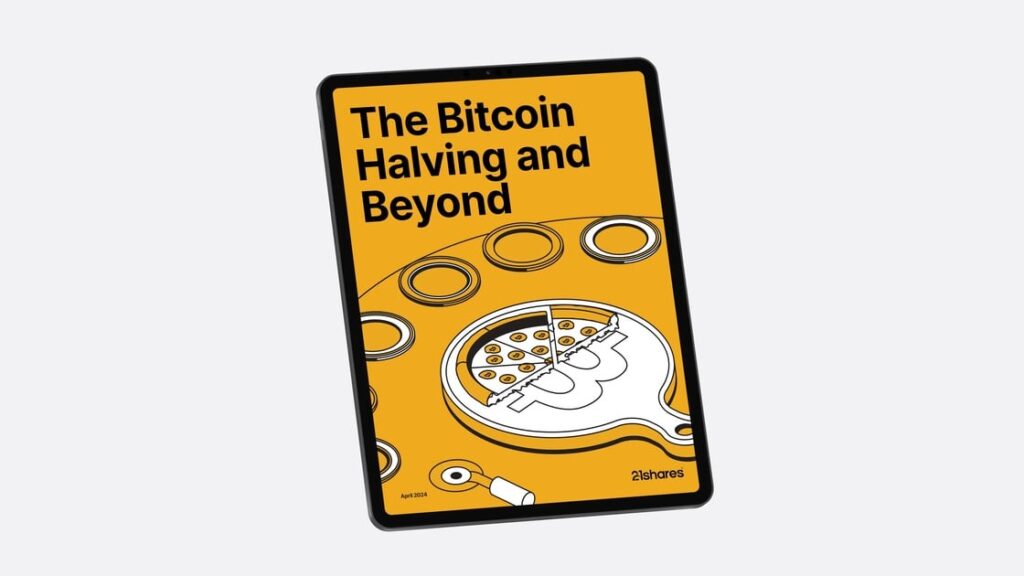
This Week’s Calendar
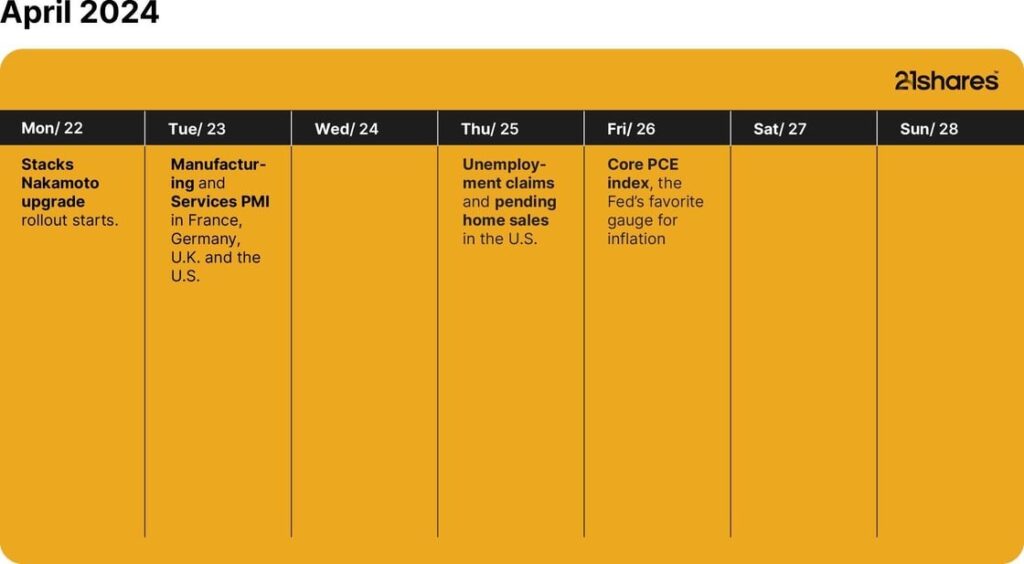
Source: Forex Factory, 21Shares
Research Newsletter
Each week the 21Shares Research team will publish our data-driven insights into the crypto asset world through this newsletter. Please direct any comments, questions, and words of feedback to research@21shares.com
Disclaimer
The information provided does not constitute a prospectus or other offering material and does not contain or constitute an offer to sell or a solicitation of any offer to buy securities in any jurisdiction. Some of the information published herein may contain forward-looking statements. Readers are cautioned that any such forward-looking statements are not guarantees of future performance and involve risks and uncertainties and that actual results may differ materially from those in the forward-looking statements as a result of various factors. The information contained herein may not be considered as economic, legal, tax or other advice and users are cautioned to base investment decisions or other decisions solely on the content hereof.
Nyheter
WisdomTree utökar sortimentet med US Quality Growth UCITS ETF (QGRW)
Publicerad
15 timmar sedanden
24 april, 2024
WisdomTree har igår lanserat WisdomTree US Quality Growth UCITS ETF (QGRW). QGRW strävar efter att spåra pris- och avkastningsutvecklingen, före avgifter och utgifter, för WisdomTree US Quality Growth UCITS Index (”Indexet”) och har en total kostnadskvot (TER) på 0,33 %. QGRW, som idag är noterat på Börse Xetra och Borsa Italiana, kommer att noteras på Londonbörsen den 24 april 2024.
Det proprietära indexet är utformat för att spåra resultatet för amerikanska storbolag med stark kvalitet (t.ex. hög lönsamhet) och tillväxtegenskaper som uppfyller WisdomTrees ESG-kriterier (miljö, social och styrning).
WisdomTrees tillvägagångssätt syftar till att ge högre uppåtdeltagande på tjurmarknader och generera positiv överavkastning över en hel marknadscykel. Tillväxtfaktorn syftar till att fånga företag som upplever tillväxt i försäljning, realiserade intäkter och förväntade intäkter, ofta inklusive disruptiva företag och tekniska jättar, vilket möjliggör större deltagande uppåt. Kvalitetsfaktorn ger stabilitet till en portfölj och hjälper till att filtrera bort de mest olönsamma, mycket spekulativa och lågkvalitativa namnen. Denna kombination positionerar WisdomTree US Quality Growth UCITS ETF som en strategisk, långsiktig aktielösning för investerare som letar efter genomtänkt exponering mot tillväxtsegmentet på den amerikanska aktiemarknaden utan att offra kvaliteten på sin portfölj.
Pierre Debru, chef för Quantitative Research & Multi Asset Solutions, WisdomTree, sa: ”Tillväxt tenderar att fånga störande och växande företag, vilket leder till högre allokering till tekniska jättar, men historisk avkastning tyder på att investeringar i tillväxtaktier utan filter kan vara en förlora spel på lång sikt. Att tillämpa en kvalitetsskärm på tillväxtaktier kan hjälpa till att säkerställa att portföljbolagen är sunda och kan leverera resultat över tid. Tillväxtaktier av hög kvalitet har historiskt sett varit bättre på att hjälpa investerare att klara avdrag än en ren tillväxtallokering utan att offra förmågan att delta i marknadsåterhämtning. Den nya ETF:n är ett alternativ till tillväxtstrategier som Nasdaq 100, eftersom den tar ett mer holistiskt tillvägagångssätt för portföljkonstruktion istället för att enbart fokusera på marknadsvärde för beståndsdelar eller deras börsnotering.”
Europeiska investerare kan nu få tillgång till QGRW, som redan är en tillgänglig strategi i USA, som initialt lanserades 2022. WisdomTree US Quality Growth UCITS ETF kommer att ansluta sig till WisdomTrees sortiment av 360 miljoner USD av Quality Growth ETFer.
Genom WisdomTree US Quality Growth UCITS ETF kan investerare fortsätta att dra nytta av WisdomTrees stilkonsekventa, transparenta och systematiska investeringsprocess med rötter i akademiskt driven forskning.
Alexis Marinof, Europachef, WisdomTree, tillade: ”Sedan WisdomTree grundades har vi fokuserat på att lansera differentierade och mervärdesinvesteringslösningar för våra kunder. Kärnan i vår aktiefilosofi är tron att kvalitetsaktier bör vara hörnstenen i varje aktieportfölj. De är avgörande för att bygga motståndskraftiga portföljer som kan hjälpa investerare att bygga upp välstånd på lång sikt och navigera i de oundvikliga stormarna. Vi vet att investerare positionerar portföljer för att dra nytta av de kommande räntesänkningarna i USA, vilket förväntas bli en positiv katalysator för tillväxtorienterade amerikanska aktier. Men som vi har sett de senaste åren utlovas ingenting på finansmarknaderna. Så, genom att fokusera på kvalitet snarare än börsvärde, kan investerare dra nytta av ett mer robust tillvägagångssätt än marknadsvärdevägda tillväxtfonder, utan att offra avkastningen på uppåtgående marknader.”
ETF information
| Namn | Avgift | Börs | Valuta | Kortnamn | ISIN |
| WisdomTree US Quality Growth UCITS ETF – USD Acc | 0.33% | London Stock Exchange | USD | QGRW | IE000YGEAK03 |
| WisdomTree US Quality Growth UCITS ETF – USD Acc | 0.33% | London Stock Exchange | GBx | QGRP | IE000YGEAK03 |
| WisdomTree US Quality Growth UCITS ETF – USD Acc | 0.33% | Borsa Italiana | EUR | QGRW | IE000YGEAK03 |
| WisdomTree US Quality Growth UCITS ETF – USD Acc | 0.33% | Börse Xetra | EUR | QGRW | IE000YGEAK03 |

Tillgång till italienska statsobligationer med fast löptid

Navigating Macro Headwinds, On-Chain Optics, and The Rise of Runes

WisdomTree utökar sortimentet med US Quality Growth UCITS ETF (QGRW)

SJPD ETF köper alla slags japanska aktier

Franklin Templeton lanserar ny fond som följer katolska principer

ETFmarknaden i Europa firar sitt 24-årsjubileum med tillgångar på två biljoner USD

De mest populära börshandlade fonderna mars 2024

3 ETF:er du nog inte visste finns

FUIG ETF investerar i hållbara företagsobligationer som följer Parisavtalet

Tillgång till obligationsmarknaden för företagsobligationer från utvecklade marknader
Populära
-

 Nyheter1 vecka sedan
Nyheter1 vecka sedanETFmarknaden i Europa firar sitt 24-årsjubileum med tillgångar på två biljoner USD
-

 Nyheter4 veckor sedan
Nyheter4 veckor sedanDe mest populära börshandlade fonderna mars 2024
-

 Nyheter4 veckor sedan
Nyheter4 veckor sedan3 ETF:er du nog inte visste finns
-

 Nyheter3 veckor sedan
Nyheter3 veckor sedanFUIG ETF investerar i hållbara företagsobligationer som följer Parisavtalet
-

 Nyheter1 vecka sedan
Nyheter1 vecka sedanTillgång till obligationsmarknaden för företagsobligationer från utvecklade marknader
-

 Nyheter2 veckor sedan
Nyheter2 veckor sedanFörsvarsfond når förvaltad volym på 500 MUSD
-
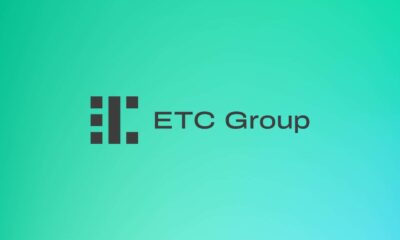
 Nyheter3 veckor sedan
Nyheter3 veckor sedanVad händer härnäst för Bitcoin?
-

 Nyheter3 veckor sedan
Nyheter3 veckor sedanNy börshandlad fond från Deka ger tillgång till S&P 500-index



